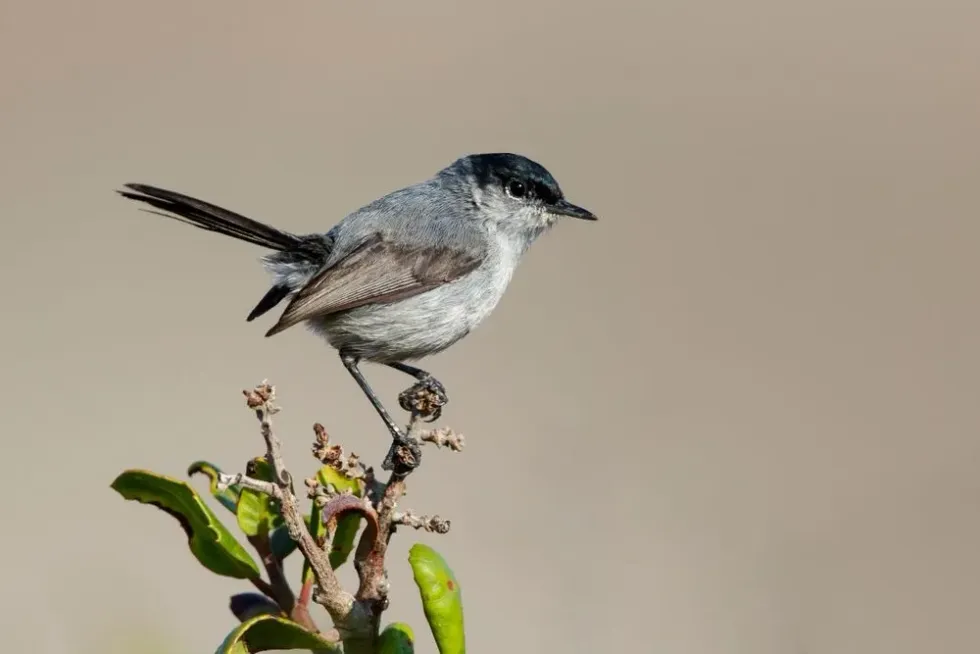California gnatcatchers or the Polioptila californica is a long insectivorous bird that can be found living in dense coastal sage scrub growth. It was recently split from the black-tailed gnatcatcher of the Chihuahuan and Sonoran deserts which looked similar. It is often solitary, but in winter, it joins with other birds.
Until the late '80s, California gnatcatchers were considered to be a local form of black-tailed gnatcatcher. However, its recognition as a full species has also made it an endangered species under US Fish and Wildlife Service, as the California gnatcatchers’ limited habitat, the southern California coast, had been taken over by the housing developments.
These birds live in a low shrubby habitat known as the coastal sage scrub that is also the home of other specialized plants and animals.
Their habitat range extends from southern Ventura County to Baja California, Mexico. Since they live in the coastal sage scrub habitat, one will have to look at gently sloping areas that have a good California sagebrush cover to find them.
In most cases, this threatened species stays tucked in. However, they meow to scare away predators.
For more relatable content, check out these chipping sparrow facts and cliff swallow facts for kids.
California Gnatcatcher Interesting Facts
What type of animal is a California gnatcatcher?
The California gnatcatcher is an endangered bird species whose habitat is the narrow sage scrub coastal strip of the California chaparral. One can find this bird from Baja California, Mexico to southern Ventura County.
What class of animal does a California gnatcatcher belong to?
The California gnatcatcher, Polioptila californica, belongs to the Aves class.
How many California gnatcatchers are there in the world?
The global breeding population of California gnatcatchers is 80,000 individuals.
Where does a California gnatcatcher live?
The California gnatcatcher (Polioptila californica) bird can be found living in coastal sage scrub, coastal dune scrub, and desert scrub year-round. In California, one can find these birds in the habitat that are dominated by the California sagebrush.
Generally, they occur in areas that are less than 1600 ft (0.5 km) in elevation. But, at inland scrub sites, they can occur at a higher elevation.
In Baja California, Mexico, the California gnatcatcher can be found in coastal dune scrub, sparse desert woodlands, and desert scrub habitat. They forage in the chaparral habitat during the non-breeding season, especially if it is bordering sage scrub.
What is a California gnatcatcher's habitat?
The California gnatcatcher's habitat is the coastal sage scrub or the soft chaparral that occurs in dry yet foggy areas. Found along the inland areas and coastal zone, this habitat is located where the marine layer has reached into the canyons and the foothills.
Throughout the range, the average precipitation is 10 in (25 cm) but might vary from year to year. In this habitat, shrubs can reach an average height of 6.6 ft (2 m). These shrubs are aromatic.
Who do California gnatcatchers live with?
The coastal California gnatcatcher bird that is found around the coastal sage scrub often lives alone. However, in winter, this black, gray, and white-weathered bird join with other birds to form a group.
How long does a California gnatcatcher live?
The average lifespan of this bird in the wild is eight years.
How do they reproduce?
California gnatcatcher birds are monogamous in nature. Their breeding season begins in late February and ends in August. Both parents build open-cup, low-lying nests in areas that have less than 40% slope gradient. The average clutch size of the coastal California gnatcatcher is four eggs that are aquamarine in color.
Both parents incubate the eggs and take half-hour shifts. They alternate between foraging for food and incubating the eggs. The whole incubation period lasts for two weeks.
The chicks of this bird are born blind and are uncoordinated. Even after that, fledgling occurs after two weeks. After three to four weeks later, they disperse from the natal territory. By October, they find their mating pair. By the following spring, they are mature enough for breeding.
What is their conservation status?
According to the IUCN Red List, the California gnatcatcher are tagged as Least Concern. The conservation status of the California gnatcatchers is Endangered under US Fish and Wildlife Service. The remaining habitat of this species in California is rapidly being turned into housing developments. Cowbird parasitism is also one of the reasons why these birds' nesting attempts fail.
California Gnatcatcher Fun Facts
What do California gnatcatchers look like?
The male coastal California gnatcatcher bird is dusky gray in color and can be distinguished by its thin black beak and black cap or crown. It has a thin, long black tail along with narrow white edges and tips on the underside of its tail features.
But, by winter, males lose their plumage colors and get the plumage color that is similar to the female of the species. Females look similar to the male, but instead of the black cap or crown, they have a blue gray one.
How cute are they?
Californian gnatcatcher can be considered cute because of its small size and dusky gray color.
How do they communicate?
The costal California gnatcatcher population uses call notes and behavior for communicating with each other. Through their calls, they are able to warn others of danger, defend their territory or scare off predators. Voice is the most noticeable communication form they use. Apart from the kitten’s meow sound, they can also squeak, trill or sing a California gnatcatcher song.
How big is a California gnatcatcher?
A Californian gnatcatcher is a small bird that is about 4.3 in or 10.8 cm in length. It is one of the smallest bird found in California along with hummingbirds. A blue gray gnatcatcher is 3.9–5.1 in (10–13 cm) in length.
How fast can a California gnatcatcher fly?
There is no speed recorded for the California gnatcatcher
How much does a California gnatcatcher weigh?
The average weight of a coastal California gnatcatcher is 0.2 oz (6 g). It is similar to black-capped gantcatcher and five times the size of calliope hummingbird.
What are the male and female names of the species?
The male and female California gnatcatchers have the same name.
What would you call a baby California gnatcatcher?
N/A
What do they eat?
The California gnatcatcher as well as the blue gray gnatcatcher either hovers above shrubs for grabbing their prey or picks insects from foliage. California gnatcatcher as well as blue gray gnatcatcher's diet mainly includes leafhoppers, spiders, bugs, and beetles.
Are they aggressive?
Yes, the California gnatcatcher can be aggressive in nature.
Would they make a good pet?
Since the coastal California gnatcatcher is an endangered species, you should not keep them as pets.
Did you know...
If the California gnatcatcher is blown by the breeze, they can flit lightly through the shrubs. They pick insects from shrubs like sagebrush and never slow down. One can hear their kitten-like harsh meow from deep inside the shrub.
However, males sometimes flick their tail while making a California gnatcatcher call from exposed perches. They are monogamous in nature and maintain their territories and pair ponds year-round.
Male chase intruding juveniles and other males out of their territory. But, they are known to tolerate lone females. Female birds of this species also participate in defending their territory and chase out females and juveniles, but not lone males.
Listed as threatened in the northern part of the Southern California range, the California gnatcatchers are used as a host by the female brown-headed cowbirds who lay their eggs in their nest. Cowbirds kick the gnatcatcher eggs out of their nest.
In some cases, these birds' eggs are smothered by the larger cowbird nestling. In most cases, parasitized nests don’t fledge gnatcatcher young.
The male California gnatcatcher will select a site for nesting in a shrub like buckwheat, sagebrush, or other species. This shrub is often within a drainage, gully, or on a gentle slope.
Inside the shrub, the nest is built near the outer edge and is about 2.5 ft (76.2 cm) above the ground. The male, as well as the female California gnatcatcher, build the nest.
But, the majority of the work is done by the male. The male finds pieces of dried vegetation, spiderweb, and bark for creating a solid base.
The female adds more materials to it. The finished nest is a sturdy and deep cup that is over 2.5 in (6.3 cm) deep and around 2.5 in (6.3 cm) wide.
The California gnatcatcher's call
The female and male California gnatcatcher give a call that sounds very similar to a kitten’s meow. Even though they make calls year-round, males make more frequent calls before and while building their nest. During this time, they make about 80 calls every hour. To scold predators and intruders, they make a harsh mew or cry.
Why is the California gnatcatcher endangered?
The California gnatcatcher species like California condor was listed as threatened in the northern part of the Southern California range in 1993 by the United States Fish and Wildlife Service.
The reason behind this was the increasing development in the coastal sage scrub, habitat of the California gnatcatcher. The current coastal sage scrub loss in the United States is estimated to be about 70-90%.
This threatened species habitat has been designated ‘Critical Habitat’ under the Endangered Species Act.
This species is vulnerable to metapopulation as its populations are often found living on prime land that is meant for housing and commerce development. Even though some of these birds' habitats have been saved in state parks and national forests, its population is still severely fragmented.
Currently, habitat conservation efforts are being made to preserve open land in Southern California for making sure that this species does not become extinct in its former range.
Here at Kidadl, we have carefully created lots of interesting family-friendly animal facts for everyone to discover! For more relatable content, check out these fox sparrow facts and common loon facts pages.
You can even occupy yourself at home by coloring in one of our California Gnatcatcher coloring pages.









